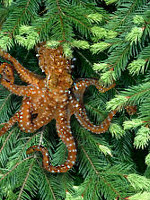Save the Pacific Northwest Tree Octopus!!

A commenter on Pharyngula made a suggestion to PZ Myers to check out the local fauna while he is in Seattle this week. One very important an elusive keystone species, Octopus paxarbolis, is under threat from
decimation of habitat by logging and suburban encroachment; building of roads that cut off access to the water which it needs for spawning; predation by foreign species such as house cats; and booming populations of its natural predators, including the bald eagle and sasquatch.
Please go immediately to Save the Pacific Northwest Tree Octopus Foundation to learn more about this intelligent and fragile species and learn what you can do to conserve this rarity!






















